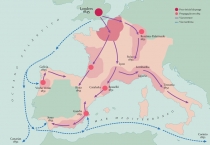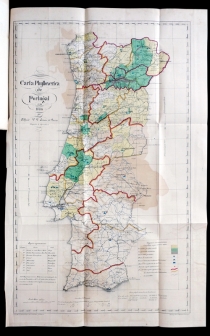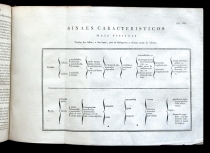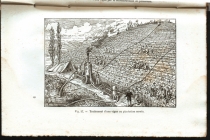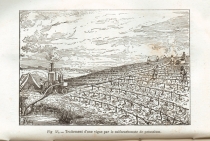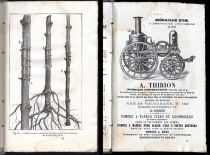The American Plagues
The “American plagues” refer to events in the second half of the 19th century. Essentially, three different types of pests were being dealt with. The first was powdery mildew, or Oidium. Before sulphur was used as a means of chemical control, attempts were made to introduce resistant stock to control the fungus. This resulted in the importation of another pest which was infinitely worse: Phylloxera.
Thirty years after the arrival of powdery mildew, Peronospora, or downy mildew, also came from America. This fungal disease brought the most serious problems to Iberian vineyards. Iberian vineyards fell into a prolonged crisis for over half a century, to the enormous detriment of both the people and agriculture in wine producing regions. From 1870 to 1930, some five million hectares of vineyards had to be entirely uprooted several times. It is worth noting that the arrival of the plagues in Spain was somewhat delayed, and was therefore preceded by an increase in demand for product from countries already infected.
The first disaster was the Oidium infestation. (See Figs. 82 and 83). Oidium Tuckeri (Unicula necator, Berk) came to Europe in1845 and spread within a few years across all viticultural areas. It was known as Cebiza or Cencilla in Spain, and Oidium in Portugal. The pathogen was discovered in 1845 in the greenhouses of a Mr Tucker in Margate (just over 100 km from London). It spread at lightning speed across Europe. It was first discovered in Peso da Régua (Douro region) in Portugal, from where it migrated to Spain.
The phenomena of heavy infestations horrified wine growers so much that in panicked response vineyards were ripped up in order to plant supposedly Oidium‑resistant Vitis vinifera varieties, or hybrid varieties, which soon proved to be even more problematic with the outbreak of the second parasite, this time, the Phylloxera.
Although the use of sulphur was taken for granted in wine making and stabilisation, it took some time before the process was implemented in the vineyard, because already in 1846, Kyle, the English scientist from Canterbury (according to Visconde Villarinho de S. Romão (2.) Flagelos da Videira, Typografia da Silveira Teixeira, Porto, (1891: 98 ff.) recognised the curative and protective effect of sulphur and was experimenting with various application techniques. Failure to understand how physiological cycles relate to sensitivity delayed its use in combating the infestation.
The second plague was the Phylloxera infestation, Phylloxera (Dactulosphaera vitifolii; Fitch). In the late 1880s, this grapevine louse spread slowly but surely throughout Iberia.
Native to North America, this insect, related to aphids, was introduced to southern France via grapevine stock imported from the East coast of America via Britain (more specifically, London) in the 1860s. In 1870, the French government established a Commission for the Control of Phylloxera, chaired by the famous Louis Pasteur. Despite reportedly reviewing over 700, their efforts proved fruitless. The appearance of grape phylloxera revived a science which was primarily concerned with its extermination. That, and ampelography resulted in the European wine industry being burdened with a huge bureaucracy which has remained structurally intact to the present day, something which some professionals conjecture might have become the greater evil of the two.
The solution to the problem turned out to be quite different.Grafting (overgrafting) of vines was already known in Antiquity. Cato the Elder (34‑149 BC) discusses the technique in his work De agricultura. Previously vines were propagated mainly to change varieties. After it was finally figured out that American vines were not infected with Phylloxera at their roots, local (Vitis vinifera) scions were grafted on to Phylloxera‑resistant vine stock from the American Vitis riparia, Vitis berlandieri, Vitis rupestris, Vitis cinerea and the Asian Vitis amurensis).
Phylloxera was discovered in Spain in 1876 (Hidalgo, 1993: 266 ff.) on a Moclinejo wine estate known as the Lagar de la Indiana in the province of Malaga. By 1878 the infestation had reached Gerona and other locations on the Costa Brava. From 1882 it was discovered in Villadervos, and in the Verín Valley near Ourense. From these three points of departure Phylloxera spread rapidly over almost the whole of Spain. Of the over 2,000,000 hectares of vineyards in Spain in 1877, only 860,000 hectares were still free from the pest in 1903. In 1918 the Canary Islands were still untouched by Phylloxera (Juan Piqueras Haba, 2001, Actas del I Symposio de la Associacion Internacional de Historia…).
The infestation altered the wine‑growing landscape of Spain, including the varieties grown, which were fundamentally changed in various regions. The V. vinifera x V. labrusca hybrid Isabella from South Carolina (USA), as well as all other hybrid varieties showed a high resistance to cryptogamic diseases (such as Peronospora and Oidium), but were for the most part themselves not particularly resistant to Phylloxera and spread this pest to new plantings. The most diverse methods of pest control were tried, chiefly the application of carbon disulphide at sometimes life‑threatening concentrations, and cold, moist regions were sought which hindered the pest’s reproductive cycle. The widespread growing of hybrids was the main cause of the Phylloxera invasion of Spain, since natural dissemination occurred much more slowly.
Only gradually, with the introduction of Phylloxera‑ resistant vine stock from America, could viticulture be re‑established. Only certain areas managed to achieve this, however; old varieties disappeared and new cultivars, fast‑growing high yield varieties from other regions, and varieties from foreign countries thought to be Phylloxera‑ resistant were introduced.
The Phylloxera infestation affected the Atlantic archipelagoes particularly badly. It was only in the 1980s, with EU financial support that hybrids were replaced with V. vinifera varieties in Madeira, the Azores and the Canary Islands.
Catalonia was geographically and politically very close to Roussillon (France), and the development of the damage symptomatic of Phylloxera infestation in the local vineyards was very similar. The Girona sub‑region fell from 37,856 hectares in 1877 to 5,185 hectares in 1889. The sub‑regions of Barcelona, Lleida and Tarragona, separated from Girona by the mountains, expanded thanks to the French demand from 200,585 hectares in 1877 to 363,085 hectares in 1889. By 1902 the area of cultivation reduced to 196,220 once the Phylloxera managed to cross this natural barrier. (Haba, 2002: 955).
It is interesting to note that in 1885, since many sub‑ regions in Iberia had managed to retain their ungrafted vines, they experienced an export boom to France, which at the time already had large experimental facilities working on American rootstock varieties.
Plasmopara or Peronospora. (Plasmopara viticola; Berk & Curt). The third and by far the worst blow to viticulture came with a pest which P. Viala 1887 had already characterised in 1887 all across Canada and the North American eastern regions as “mildew”. (Pierre Galet, Les Maladies de la Vigne e les Parasites, Volume 1, 1977: 89; Paysan du Midi, Montpellier). In 1878, in the Gironde, Peronospora oil spots were found on Jacquez, an American hybrid vine. By 1880, the fungal disease was spreading all over Europe.
Its dissemination occurred so rapidly in Iberia that a chronological map would be meaningless. With both pest phenomena, the destruction of the foliage is nothing compared with the economic consequences of grape rot. The search for a chemical compound to treat this disease took a long time although scientists Viala, Millardet, Berkeley and Patrigeon soon understood the physiological functioning of the pathogen. Copper sulphate was applied, after scientific experiments had been conducted to find a better method of combatting the disease (Galet 1987: 142 ff). It was only at the end of the 20th century that this disease could be controlled with a failsafe, systematic and curative pesticide.
The first generation of American direct producer vine varieties and hybrids (HPD = hybrides producteurs directs – direct producer hybrids) were the first successful solution, but problematic in themselves. The American hybrid grapes were already known in the 18th century, as evidenced in reports from New England on these large berry, aromatic varieties. When the French vineyards had to be uprooted because of the American pest infestation, Millardet (1885: V) referred to M. Lalimant from Bordeaux (1869) at the Congress of Baune who said that “some American grape varieties would have withstood Phylloxera, had their grapes not been destroyed. … In response to a request by the Ministry for Agriculture, Mr Planchon has now undertaken a journey to America to investigate this problem.” F. Sahut (1885: 51‑60) describes first field trips related to testing resistance in European grapes, then the attempt to rehabilitate French vineyards with hybrid grapes in which he refers to the field trials on a collection of American grape varieties in Las Sorres près Montpellier, and details the problems of compatibility compared with the French noble varieties and also their variable resistance to Phylloxera.
Owing to the abundance of Vitis species in the Americas, it is assumed that many hybrid vines arose from spontaneous, natural, and interspecific pollination. The majority of known hybrid vines, however, have been artificially created. Sahut and other French authors initially suggested their lack of suitability to quality wine in Europe because of climatic differences, but because they were Phylloxera‑resistant direct producer varieties, conceded that it would be possible later to upgrade many plants simply by grafting on Vitis vinifera varieties.
From 1880 systematic grafting of European grape varieties to American root stock was carried out (See Figs. 92 and 93).It is astonishing that a systematic attempt at grafting only happened at such a late stage, from which one can conclude that the techniques which were so well‑known in ancient times were no longer that widespread and seldom used. Nevertheless, the results were discussed at various congresses convened by the “national anti Phylloxera commissions” which sprang up all over Europe, and grafting experiments using different varietal root stocks of American origin and Vitis vinifera varieties were conducted. Quantifying the range of known grapevine varieties, species, and hybrids in Portugal and Spain led to new insights (Menezes 1987: 5‑139). Interestingly, with these collections of data on the Iberian Peninsula, awareness of grapevine varieties grew and the art of ampelography gained momentum, viz. Vila Maior, Vasconcelos and Acúrcio Rodrigues in Portugal, and Simón de Rojas Clemente, Abela y Sáinz, Manso de Zúñiga and Fernandes de Bobadilla in Spain.
Because Peronospora from America had invaded Iberia in the interim, and the successful field tests with “grafted” vines were themselves called into question, many scientists and viticulturalists continued to favour the American species and their hybrids, believing that a solution could be found with the sulphate‑sulphur and Calda Bordalesa (Millardet’s Bordeaux mixture: copper sulphate plus hydrated lime). Thus, the first phase involved replanting vineyards with Phylloxera‑resistant varieties which were also resistant to Oidium and Peronospora (S. Sahut, 1885: 57 ff).In Europe, the first‑generation direct producer varieties (HPD) such as the Isabella, Scuppernong and the Cape –which were well‑known – were followed by the Delaware, Clinton, Concord, Cunningham, Solonis, Riparia, Vialat, Tayler and Jacquez cultivars. They became very popular at the time. Azores, Madeira, and entire regions on the mainland followed this trend and were quick to change over to these varieties.
Later, Catawba attracted much attention. First, Millardet (1885: 153) attempted to differentiate between the various types of direct producer hybrids and “espèces sauvages” (wild species), and to assign typical characteristics and tolerances to the natural environment (soil, climate) to the latter according to their geographical provenance. This was to be vitally important when assessing their suitability for rootstock breeding. At the same time, Sahut P., (1885: 149 ff ) described an additional 35 direct producer varieties, although Millardet A. (1885) was aware that a far greater number of resistant American direct producer varieties existed.
One vital issue is rootstock breeding, which to some extent arose as a side effect of the hybrid breeding and effectively rescued Iberian viticulture. A wide range of rootstock types needed to be used to achieve the additional benefits of Phylloxera‑resistant roots. Variable shoot development, drought resistance, moisture susceptibility, nematode resistance, soil chemical properties, and affinity issues are the reason rootstocks are still being actively researched. (See Luis Fidalgo, 1999: 345 ff ).
Consumers adjusted only reluctantly to the unusual character of the hybrid wines with their foxy quality. Ultimately, it was a question of price which best prepared the market for the cheap hybrid wine, since the V. vinifera wines had become scarce, or often had to be sourced from far away, which made them more expensive. Because of the delay in the arrival of the American plagues, it seems that Iberian countries were able to profit most from the countermeasures taken by the French and Germans, and actually suffered less from the hybrid wines than they did from the artificial wines produced in response to the booming demand for V. vinifera wine as a result of France’s major supply crisis, which, of course, would later affect them.
The scientific breeding of hybrids using European stock (second generation of interspecific varieties) began in the 1880s. Millardet (1885: IV) pointed out that the property of Phylloxera‑resistance was strictly hereditary. This naturally stimulated brilliant agronomists and biologists to ponder on how best to combine oenological and viticultural characteristics with Phylloxera resistance. In 1886, in his book, À la memoire de Louis Bouschet et d’Henri Bouschet, Pierre Viala describes the first great breeders, their methods and results. Based on the findings gleaned from the example of the Alicante‑Bouschet cross‑breeding, systematic attempts started to be made in large‑scale trials to cross varieties of different species. In 1885, A. Millardet described the hybridisation of the resistant American grapevine varieties. Since producing wine from the American hybrids which corresponded to the quality of Vitis vinifera varieties was certainly not expected, efforts ensued to combine the desired positive hereditary properties of both species, whilst excluding the negative one (the flavonoid Malvidin 3,5‑diglucoside, which produces the “foxy” taste).
These interspecific hybridisations became big business. With each additional backcrossing, several American hybrids became more Vinifera‑like. Desperate vintners (in Spain and Portugal, too) paid a fortune for these new hybrids with Vinifera parentage. The Baco noir and Baco blanc varieties, bred by François Baco (1898) had become well‑known, and are still used today in the production of Armagnac. Albert Seibel from Aubenas was probably the best known breeder, with his Cascade, Rosette, Chancellor, and Rougoeon, or Aurore varieties. The breeder Couderc from the village of the same name (responsible for Couderc noir) engaged him in an economic war over the marketing of his varieties. Bertille Seyve produced the Seyval blanc. Because he married the daughter of the vine breeder Villard, subsequent varieties bred by the family bear the adjunct Seyve‑Villard, the most important one being the Chamboursin, which is still planted today.Vine breeders in Italy included Bruni, Paulsen, Pirovani and Prosoeri. In the Balearic Islands, as well as across the whole Iberian Peninsula, particularly in those areas under severe fungal attackon the coast or on rainy slopes (such as Lafões, Portugal), the Isabella, Cunningham, Herbemont and Jacquez varieties were used extensively. This gave rise to the vinhos de cheiro (aromatic wines), morangueiros, and americanos. There were no known scientific HPD (direct producer hybrid) breeding experiments conducted in Spain and Portugal from this period, just as scant quantitative documentation exists with regard to the dissemination of first and second generation hybrids on the Iberian Peninsula.
Vine grafting. It appears that at the time of the Phylloxera epidemic the careful art of vine grafting was hardly used in France or the Iberian Peninsulaalthough it had already been described by the Greeks and Romans: Theophrastus, Cato, Virgil, Pliny, and Columella (F. Sahut, 1885: 179). Ultimately, a new vineyard took severalmore years before the first harvest. Issues of affinity and lower yield, not to mention susceptibility to cryptogamic pathogens, were the chief obstacles to rapid adoption of the practice of grafting, although in 1879 seminars were already being held and publications made available on how to produce seedlings (S. Sahut, 1885).
Grafting, which really represents the beginnings of biotechnology of the grapevine, initially took place in the vineyard in the traditional manner. Production of grafted grapevines in the workshop or vine nursery soon provided an alternative to grafting one‑year‑old American rootstock in the field. Manual techniques (tongue cut) were now competing here with mechanical ones. Choosing the right rootstock and the correct grafting technique became the fundamental issues of scientific research. At the time F. Sahut (1885) counted 15 different rootstock varieties, none of which are used today. Thus, the labour‑ intensive drawbacks of vine grafting came face to face with understanding the dynamics of direct producer hybrids.
 Fig. 82 e 83: Powdery mildew, or Oidium Tuckeri came unnoticed from London with new table grape varieties and spread all over Europe. Within a few years it had infected all the coastal regions of the Iberian Peninsula. The Oidium infestation emanated from three main regions: the Douro, Roussillon, and Valencia (according to Juan Piqueras Haba, 2010).
Fig. 82 e 83: Powdery mildew, or Oidium Tuckeri came unnoticed from London with new table grape varieties and spread all over Europe. Within a few years it had infected all the coastal regions of the Iberian Peninsula. The Oidium infestation emanated from three main regions: the Douro, Roussillon, and Valencia (according to Juan Piqueras Haba, 2010).
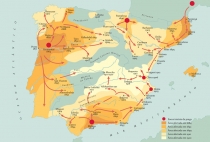 Fig. 84: Portugal confronted the previous incidence of Phylloxera in the Douro and Ribatejo by thoroughly evaluating its vineyards, implementing massive planting experiments using both its own and imported varieties, and establishing three regional commissions to combat Phylloxera. Spain had the good fortune not to have the main viticultural regions in the North attacked until decades later, and thus benefited from the considerable export opportunities which presented themselves as a result. (Hidalgo Luis, 1999).
Fig. 84: Portugal confronted the previous incidence of Phylloxera in the Douro and Ribatejo by thoroughly evaluating its vineyards, implementing massive planting experiments using both its own and imported varieties, and establishing three regional commissions to combat Phylloxera. Spain had the good fortune not to have the main viticultural regions in the North attacked until decades later, and thus benefited from the considerable export opportunities which presented themselves as a result. (Hidalgo Luis, 1999).


